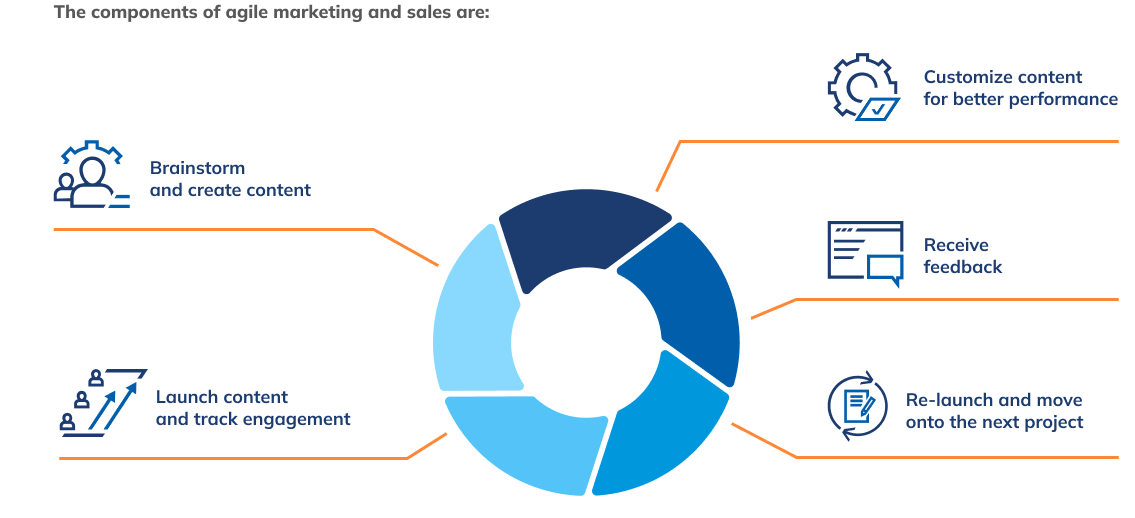Outlook 2022: What’s Next in B2B Marketing?
Introduction
As the ever-evolving B2B landscape continues to present unique challenges for B2B marketers, change also means new possibilities and opportunities. It is only natural to question how the B2B market will continue to shift in 2022, and which strategies will be the most effective for managing change.
In INFUSE’s outlook for 2022, our industry experts forecast the upcoming trends and their impact on not only demand generation, but the B2B marketplace and how we work in general.
Update
Outlook 2022 was written in December 2021, before the invasion of Ukraine.
Therefore, this piece has been revisited, with new considerations (labeled as “update”) and a new section on Cyber Resilience to reflect on how this escalating war has and will continue to change the predictions we made at the end of 2021.
Our focus will be on the impact of the conflict on B2B growth marketing. We believe that any geopolitical commentary would be out of place and beyond our expertise.
Demand Generation
As a strategy, demand generation has to rise to meet the changing needs and pain points of target audiences both in the short and long term. As such, for demand generation campaigns to be successful in maintaining lead interest over extended periods of time, they must be adjusted to meet current trends.
Below are trends that we believe are bringing transformation to the B2B demand generation space and are likely to have a significant impact on strategies in 2022.

Update
The conflict in Ukraine will surely affect the energy sector and possibly cause food shortages in Europe and the Middle East, with prices skyrocketing globally. Price surges are also expected for commodities such as gas, oil, fertilizer, wheat, and sunflower oil as Russia and Ukraine are top suppliers of these goods.
This instability will likely encourage B2B companies dependent on these commodities to decrease marketing spending, which in turn decreases the scope and potential of demand generation campaigns.
However, we advise against freezing marketing spending as it may hamper growth for years to come. The COVID-19 pandemic has shown us that businesses that maintain a steady flow of demand are the first to emerge out of a recession as the economy kicks back.
Therefore, moving forward, B2B businesses should aim to rethink their marketing priorities and ensure business growth, by keeping an eye on the global economy and how it affects your operations and sales.
This could be the moment to shift perspectives on marketing, focus on what truly generates ROI, and reorganize your teams to optimize workflows. Achieving great success is still possible, even in these difficult times.
What the B2B user experience can learn from B2C
With millennials and Gen Zers joining major B2B enterprises, “B2C experiences” have been spilling over to the B2B market.
This has led to the expectation for B2B to have B2C-style client support with rapid response times. Such a change is significant, as B2B marketing remains an industry that continues to rely on offline mediums quite a bit, such as phone calls. These steps are integral to the B2B sales process and allow SDRs to encourage direct interaction with prospects as they search for more information on products/services.
The hype surrounding User Experience (UX) design also entered the B2B arena, transforming dull websites and content into interactive, rich media. With the forced digitization of businesses as the world continues to recover from a global pandemic, changes to UX design are set to be an ongoing trend. B2B companies with poor design will be outperformed by their competitors as the value of a seamless experience continues to rise.
Besides UX, these four trends will make B2B marketing more similar to B2C:
Voice search
The Voice Recognition market is set to grow from 10.7 to 27 billion dollars between 2020 and 2026. This impressive growth will be led by voice search, mostly with smartphones and devices such as Alexa.
The “spillover effect” of B2C into B2B will also translate into voice search, especially with remote workforces. Employees that have smart devices will use them to ask questions while multitasking, just like they do in their personal lives.
This means companies should conduct an SEO audit for voice search and optimize content for the most common queries. It’s an added layer to the SEO strategy that B2B marketers should implement in 2022.
Chatbots
The on-demand convenience of chatbots isn’t something only the younger generations celebrate: 66% of millennials and 58% of baby boomers consider 24-hour support the key benefit of this technology.
This aligns with the client expectation of quick service and requires B2B marketers to program chatbots that can assist users when no reps are available. That means clear pricing for offerings works best—after all, setting up a chatbot just to request a quote isn’t taking advantage of its potential.
Your chatbot is also a gateway to educational assets for your leads whenever they ask FAQs or choose from predetermined chat options. Combined with AI and Machine Learning, the chatbot will learn what content on your blog best aids leads in their brand discovery, improving the user experience over time.
Therefore, the popularity of chatbots and their potential to polish and streamline the visitor experience as a smart website feature make them an obvious choice for 2022.
Interactive emails
Over 20% of marketers believe design is improving their email engagement, and adding interactive elements with CSS or AMP is a huge part of it.
By adding quizzes, image carousels, and drop-down menus, marketers can increase the click-through rates (CTRs) and open rates of their emails. In fact, interactive emails increase the click-to-open rate by 73%.
If you are looking for inspiration, Really Good Emails has an entire section dedicated to interactive emails.
B2B influencer marketing
Influencer marketing has been consolidated for years in B2C, but the rise of thought leadership in B2B has provided leeway for influencers to pitch products and positively influence their audience.
However, B2B marketers need to be aware that influencer best practices can’t be simply transposed from B2C—and they shouldn’t expect the same results.
in B2C, the sales cycle is typically shorter and involves less research by fewer decision makers. Meanwhile, in B2B, your influencer will need to generate interest throughout your entire sales cycle.
This means that a B2B influencer campaign might only impact sales six months or even a year later, especially when considering the unpredictability and complexity of the B2B buying process.
This also adds weight to all marketing efforts, including social media, as leads need to be consistently engaged and require nurturing over a longer period of time.
B2B social media also differs from B2C in terms of its focus. B2C social media influencers act as advocates by often promoting an improved lifestyle or experience as a result of purchasing a product. Thus, the product, the company, and its culture are also being marketed by association.
However, in B2B, social media is typically used to establish a brand and its products first, with client reviews being the principal showcase of product and service benefits. While featuring company culture and strong brand marketing in social media can also boost B2B companies, credibility from demonstrating previous results for clients is a more powerful influence.
B2C influencers consider product sponsorships as part of their full-time job, which makes them readily available for your marketing needs. Meanwhile, a B2B influencer usually has a desk job and duties booking up their calendar—you’ll need to schedule your content around their availability and be reasonable with deadlines.
Even so, striking a relationship with a B2B influencer can increase content outreach and brand awareness, as well as generate touchpoints with leads beyond your proprietary channels.
How to find a B2B influencer best-suited for your brand
To find the right influencer, you must first define the target audience for your specific campaign goals.
While you may instinctively prioritize an influencer with a larger following, smaller “micro” influencers often have higher engagement rates and a better, more established relationship with their audience.
The caveat is that their audience is normally more niche when compared to larger audiences. Therefore, you should first establish your objectives, before looking for an influencer who will help you achieve them.
You can source influencers on LinkedIn with hashtags, for example. If you work with account based marketing or are looking to promote a campaign related to that subject, you can search for #accountbasedmarketing to view the top posts and key speakers. This also works for Instagram and Twitter, although LinkedIn is by far the most advantageous platform for B2B marketing.
There are influencer marketing tools, such as BuzzSumo, which allow you to find the most popular content for certain keywords. You can reach out to the authors of these articles and ask them to publish guest posts on your company blog, or even star in your webinar or podcast.
Events are also a great place to source influencers, as key speakers have a big social following and are willing to provide a platform for B2B services they believe are useful to their audience.
Leverage your team as B2B influencers
Rather than or in combination with outsourcing a B2B influencer, another option is to position employees as influencers. However, to stand out on a crowded platform such as LinkedIn, it is imperative to choose team members with the end result in mind.
While some employees, such as members of your sales team, undoubtedly have broad networks, their connections are unlikely to be looking to them for thought leadership. In this case, leveraging C-level executives as B2B influencers can be far more effective.
Executives tend to have an extensive network made up of others in similar roles, as well as business connections and other interested parties who may be following them for future job opportunities. This, in combination with their status, adds weight to their thought leadership content and is more likely to create network-building discussions.
Employees can also help to boost brands and their campaigns by taking part in company-wide marketing campaigns on social media linked by the same hashtag. In this way, they act as brand advocates and expand a campaign’s reach.
In both cases, the focus on the people behind an organization on social media can help to build relationships with prospects and add value by humanizing a company.
B2B social media and influencer marketing strategies:
- Co-marketing: Partner up with another company in your industry to share content. When it comes to lead generation, you can share data among partners, if this is clearly stated in the opt-in form.
- Guest posts: Your C-suite members can write posts for relevant blogs in your vertical. If, however, they don’t have time, ghostwriting under their guidance and final approval of the copy is a solid alternative.
- Client surveys: A powerful strategy for making your social media resonate with audiences better is to collect feedback with surveys of existing clients or target audiences. Use these responses to inform language and topic choice for content.
Demand generation: The essential checklist for planning growth strategies for 2022
Building a powerful demand generation strategy requires consistent evaluation to keep up with evolving trends, needs, and expectations. Follow this essential checklist to develop and adapt your lead generation strategy for success in 2022.
If you already have a content library, moving into 2022 is an ideal time to analyze content performance. Determine which pieces resonated with your audience the most to guide your content creation for 2022, and what can be repurposed.
If interaction alone is not indicative of this, consider running paid advertising to collect more analytics and test how a paid campaign would perform. Pay attention to trends and adapt those that work for your brand. Make sure any additions to your strategy match your brand image and voice. A variety of content including thought leadership can go a long way, both in terms of format and length.
Consider adjusting these tactics and your cadence for 2022 using the data you have collected over the past year.
Neuromarketing & the Buyer’s Journey
Understanding the motivations and the individual processes that lead up to a purchasing decision has always remained a challenge in the more complex B2B buyer’s journey.
However, there are always new strategies designed to uncover insights into how to reach different accounts, their buying committee, and ultimately, influence a purchase.
Below, we explore evolutions in this process, both in terms of technique and general approach.

B2B neuromarketing
Neuromarketing uses brain scans (such as EEG and fMRI), AI webcam tracking, eye scans, and even UX heatmaps to evaluate the emotions of leads interacting with your brand.
Evaluating emotion, the raison d'être of psychology since the times of Freud and Jung, has long been a key topic for advertisers and marketers, but mostly tackled with surveys and focus groups.
Now, neuromarketing is becoming an in-house skill at major brands, such as Time Warner, Microsoft, and Google. And with the appearance of neuromarketing agencies worldwide, smaller brands can outsource it for insights.
Affectiva, for example, is a SaaS platform that tracks the emotions of virtual conference attendees, as well as in-person focus groups with a webcam. Thus, you can evaluate your prospects’ emotions during video ads and their reactions to questions in a qualitative research.
Neuromarketing and semiotics
Neuromarketing also emphasizes the need for a pragmatic approach to marketing, not only in the language used but also in content design. Messaging needs to be guided by a pragmatic understanding of a target audience, as a campaign is often subject to interpretation past its intended form.
This level of scrutiny also extends to the design of marketing materials. Semiotics is just as important for relaying the overall message of content, as audiences form an instantaneous impression from the feelings associated with visual choices.
Simply put, this semiotic process, coined by the likes of Piaget and Kant, is threefold: the intended message, how the message is represented, and finally, how the audience actually interprets the message.
For effective neuromarketing, marketers need to build and adapt campaigns with this understanding in mind, and ensure a clear symbiotic relationship between the textual and design elements of content.
This is essential in creating and guiding an emotional response to marketing materials that stimulates and resonates with target audiences.
Real-time buyer enablement
It’s no particular news that buyers want to be enabled in real-time. That means removing any bottlenecks, which require salespeople to intervene on the prospect’s behalf.
In other words, the more brand discovery (and better yet, even purchases) the lead can fulfill on their own, the better. Especially when it comes to buying committees, leads want to perform their own independent research on which solution is best suited for their company.
This represents a potential shift from prioritizing behavior tracking and lead generation to a “client support” perspective in strategies. In this case, content that is essential to inform purchases would be kept ungated and leads could be allowed to finalize quotes with an online tool rather than an SDR.
While adapting to this trend might be a challenge for many B2B companies, the prevailing takeaway is the need for client-centric services. Even though the line between the B2C and B2B buying experience is beginning to blur, there are still many who value and prefer more interaction and guidance.
Therefore, it is essential for marketers to appreciate not only how buyers prefer to make informed decisions, but also how they work.
Buyers are under pressure to make purchasing decisions in spite of their busy schedules. It is only natural that they seek a buyer’s journey with the least amount of friction possible.
The value of deep nurture
Nurturing has always been an important facet of the lead generation and demand generation process, and 2022 will be no exception. As the economy continues to recover, nurturing on a deeper level will become even more valuable.
Although many buyers may not be in a position to purchase products yet, the approach of account based marketing (ABM) combined with deep nurture may be a solution for boosting revenue when the timing is right.
Essentially, deep nurture is targeted nurturing that is designed to reach prospects across more channels, rather than just the inbox. This could consist of paid search, social media outreach, retargeting based on site activity, programmatic display, or even offline tactics such as gifting.
For these channels, marketing teams should develop a variety of materials that are specific to each segment and account, if possible. Thought leadership is particularly effective for nurturing, as it establishes a brand as an industry leader.
Choosing the right executive or team member to be the face of campaigns and topic relevancy are important to strategize. Content should be specific and valuable to succeed in building a positive brand image.
Sales enablement content must also be a priority, so that sales teams can stay active with their outreach to prospects who require more nurturing.
Investing in accounts with personalized deep nurturing adds long-lasting value and is crucial to encouraging future purchases, even if there are no immediate returns. Marketing and sales teams should view deep nurturing as establishing a solid foundation for fruitful relationships with prospects.
Marketing Operations & Sales Enablement
As the buyer experience continues to evolve into a streamlined, seamless process, it will influence future changes to marketing operations and sales enablement.
Due to the forced digitization caused by the pandemic, marketing and sales teams became tech-savvy, and in-person meetings were replaced by product demos and virtual conferences.
This shift in the sales process will persist beyond the pandemic, and organizational changes promoting technology and productivity will become the norm in B2B companies. Efficiently measuring ROI and conversions will be paramount in all marketing operations, as constrained budgets will persist in 2022.
With this in mind, it is important to accurately measure both marketing and sales processes to be able to keep up with this changing landscape.

Update
The conflict in Ukraine will likely constrain marketing budgets at companies in the vicinity of Ukraine, or that do business with the country in general.
The possibility of a European financial crisis may drive B2B companies in the continent towards performance marketing, as it has the highest ROI with accountable metrics.
Expect CPC campaigns to gain a stronger footing than before, as lofty demand generation campaigns are replaced for micro-targeted performance marketing.
Rise of multi-channel attribution
Multi-channel attribution models will become the norm for qualifying leads in B2B. Indeed, in a recent eMarketer survey, eighty-four percent of US companies answered that they will use multi-channel attribution in 2022.
Multi-channel attribution qualifies leads according to their touchpoints in several channels with multiple assets, including social media, email, blog posts, and programmatic ads. It is a blended approach, which scores the lead based on an overall view of their engagement, instead of analyzing singular interactions.
To make things clearer, imagine a prospect that’s been interacting with content for over three months. Without multi-channel attribution, marketers and salespeople tend to analyze only the first or the last interaction as the most significant event.
Meanwhile, with multi-touch attribution, an AI algorithm scores the lead by analyzing their data more holistically, which accounts for their sales readiness with more accuracy. Not only does this deliver valuable insights, but it also helps boost morale, particularly when marketing and sales teams are aligned in reaching the same or similar key performance indicators (KPIs).
Enable salespeople with digital applications
The digitization of the B2B industry is well underway due to the pandemic. And with it comes a new trend to arm salespeople and account managers with technology to better engage prospecting.
This includes teaching salespeople how to use automation apps, such as Zapier and IFTTT, which allow them to tailor their own lead nurturing campaigns without relying on marketers. Developing product demos that salespeople can showcase immediately (such as on a tablet in-person) is also a game-changer that will reel in attention.
By implementing digitization and adding more tools to the sales team’s arsenal, more data can be collected and evaluated. And even if digital applications bring salespeople independence, team alignment is crucial—consistent feedback between sales and marketing teams allows strategies to be informed and improved.
Remaining adaptive in this way helps salespeople to not only implement creative solutions for reaching their leads, but to also personalize their outreach on a larger scale.
In short, the more tech-savvy your salespeople are, the more your brand will benefit, as they can follow their own metrics for success.
B2B agile project management
A staple for tech teams, the agile methodology is being adopted by marketing and sales teams to launch campaigns faster and adapt easily to market changes.
With the agile approach, marketing and sales focus more on launching campaigns and receiving feedback, making necessary adjustments in quick sprints to achieve the desired results. In other words, instead of a lengthy planning phase, the agile approach is “reactive” with marketing and sales content being pushed out quickly and tested rapidly in an always-on test-and-learn approach.
Already followed by some B2C agencies, the risk-averse B2B market has been reluctant to adopt this method. However, this represents a chance to get ahead for those who are ambitious enough. In an environment of rapid change, agile marketing and sales can make your brand gain the edge as you launch content and engage leads quicker than competitors. Also consider the scrum methodology, commonly adopted in software development, which falls under the agile framework.
The components of agile marketing and sales are:
With sales, the same steps above can be followed, but tailored for email cadences, LinkedIn messages, and sales meetings. The idea is to not stall in a “production phase”, but rather push out pitches and engage leads.
This cycle of feedback and continuous improvements also has the potential to demonstrate a company’s ability and willingness to adapt to the ever-changing expectations of their prospective clients. Doing so can benefit a company’s positioning, particularly in the case of direct feedback from prospects through various collection methods such as surveys which facilitate the accuracy of improvements to the buyer experience.
Both current and potential clients expect and value open communication between buyer and provider. Agile marketing is an opportunity to achieve that.
Performance marketing
With this method, marketing is measured specifically by its performance in terms of conversions, clicks, or leads. Commonly, B2B brands will hire performance marketing agencies and pay per result, which makes this method one of the easiest to prove ROI (no result = no payment).
Even so, if the campaign is successful, brands might spend more than they would with a conventional agency and a pre-paid deal.
So, performance marketing is best for brands that are underperforming in their campaigns and wish to drive up results in a short timeframe, or those companies undergoing massive changes to their strategies, product offerings, revenue share—in other words, any marketers who strive to revolutionize their industry and gain significant momentum.
Performance marketing metrics
Since this method pays per result, the KPIs are defined before the campaign is launched.
Below are the most common KPIs used by performance marketers:
- CPM (cost per mille, a.k.a. per thousand): With this metric, the client pays for every one thousand impressions generated by the campaign. For example, if the campaign is a YouTube video, the payment will be made for every one thousand views.
- CPC (cost per click): Price per click on an ad, internal link, or even CTA in an email. CPC campaigns can be costly, especially in competitive industries such as technology, however are among the most promising in performance marketing—after all, you pay for direct engagement.
- CPA (cost per action): Campaigns that aim to drive a specific action from prospects, such as downloading an eBook or watching a webinar. Along with CPC, this is one of the most valuable performance marketing metrics.
Performance marketing types
Performance marketing is usually multichannel, meaning the marketer will leverage several channels to hit their KPI goals. In other words, if the campaign has a CPC goal, the marketer will prioritize the channels that will earn the most clicks.
This can be good or bad, depending on the mindset of the marketer. For example, generating clicks from Google Ads for irrelevant keywords will hit the CPC quota, but won’t convert into sales later on. So, it is important to launch performance marketing with reputable agencies/professionals.
Here are the types of performance marketing:
- Affiliate marketing: Consists of striking a relationship with affiliates, who feature your ads or links on their websites, videos, or even offline media. Affiliates are typically paid per click (CPC) based on their affiliate marketing agreement and most links have unique trackers to detect who clicked on them and what content they consumed. In B2B, Promo and Supermetrics are affiliate marketing networks you can leverage.
- Native advertising: Content, ads, or social media posts that “blend in” with the regular editorial content the audience is accustomed to. What is considered native advertising varies from publisher to publisher, so a performance marketer will leverage the platforms they control to reach your KPI goals. File-sharing platform WeTransfer features creators on its homepage, a subtle form of advertising that blends in with its design organically.
- Sponsored content: Also known as branded content, these are paid-for articles on blogs and traditional news websites. It is typically labeled as sponsored or advertisement, so this content isn’t as subtle as native advertising for your audience. An example is the sponsored content on Entrepreneur.
Cookie-Less World
With Google Chrome phasing out cookies in 2023 (and Chrome featuring an impressive 64%+ of the global browser market share), marketers will need to adapt their campaigns and websites in 2022 to a cookie-less world. In other words, next year, companies will need to test alternatives to track behavioral data.
The removal of cookies presents many companies and marketers with a unique challenge. However, it is also an opportunity to improve upon the limitations of cookies by finding a less fragmented and more universal alternative.

Update
The conflict in Ukraine might postpone the death of cookies by Google, since the company planned 2022 to be a transition period for companies to adapt (it is also worth mentioning that Google has an office in Kyiv).
Many European companies, as well as businesses that operate in Europe, may well be understandably more focused on the war than internet cookies, leading to the transition being possibly delayed.
This will likely be another shift in marketing that is dependent on how long the conflict in Ukraine endures.
Contextual targeting is an option, with ads placed in contextually relevant websites and social media for buyers. This would include, for example, a banner ad on MedTech in a popular healthcare blog. As a result, the content users will see is based purely on the context of the other content being consumed, rather than a broader behavior profile, yielding a more favorable user experience outcome.
This, however, creates the necessity for highly specific ads for target keyword groups and site pages, as well as a need for a better alignment between advertiser and publisher for large-scale applications.
By leveraging content as the new “cookie” in contextual targeting, marketers can take advantage of the opportunity to differentiate advertisements with content that informs and entertains.
Pixels which track IP addresses are also an alternative, since the user’s geolocation can be easily discoverable. However, this tactic may be more of a challenge in today’s workforce environment, since many companies have permanently moved away from requiring their employees to co-locate in offices and have adopted working from home as a result of the pressures of the pandemic.
The impact of a cookie-less world on buyer intent
With the imminent loss of third-party cookies, the way marketers measure and interpret intent signals will have to be adapted to meet this challenge.
One way of combating this challenge is to increase efforts of first-party data collection. CRM data and interactions on proprietary sites with content/product pages and how visitors navigate through the website can be indicative of changes to the visitor experience.
This data should also be used to inform outreach. For example, prospects who have already demonstrated interest by requesting a demo and have consumed relevant content should not be offered or nurtured with the same content as top-of-funnel leads.
The ability to capture and utilize first-party data to reach out to prospects with higher levels of intent is invaluable. It is also important to remember that while this shift is uncomfortable, its effect is global, which will result in a level playing field for advertisers.
In other words, in a cookie-less world, companies that have proprietary databases will prevail in their marketing campaigns—and those who rely on cookies until its death in 2023 won’t have time to adapt. That’s why it’s important to plan this transition now.
Staffing
Perhaps the greatest and most dramatic impact on the professional world as a result of the pandemic continues to be the evolution of staffing and the individual roles within companies. Businesses must continue adapting their workforce to meet the changing landscape and job market.
The way that teams are built back after the cutbacks of 2020 will instigate a new round of changes that will shape the future of work into 2022 and beyond—and nowhere is this more apparent than in B2B marketing, which historically relies on work that can be performed from-anywhere.
Below we explore emerging trends and how they affect the structure of companies, the working life of employees, and what this means for the future development of executive-level positions.

Update
As of the writing of this update, the war in Ukraine has already caused an influx of over 3.5 million refugees in Europe, particularly Poland, Romania, Moldova, and Hungary—with many more expected to flee the longer this conflict endures.
These refugees include talent from B2B companies that escaped, as well as Ukrainians hoping to resettle and find work after evacuating. The new labor pool will impact staffing, as many companies are already championing campaigns to employ these refugees.
Ukraine is known as a tech hub and these professionals are either relocating to new countries and working remotely, or continuing to work in Ukraine albeit in not the safest of circumstances. Companies with staff still resident in Ukraine will need to be thoughtful and compassionate, prioritizing safety over productivity and all else.
If the conflict endures, Ukrainian offices and staff will need to be permanently relocated. This transition can be costly and take time until teams get back to their usual routine and productivity.
Going forward, global B2B businesses can learn a lesson of business continuity and resilience—namely, mirroring operations and positioning cross-trained talent in more than one geography to keep the business running smoothly in times of crisis.
Opportunities for growth with remote workers
What is adversity for some can become an opportunity for others. The pandemic not only led to unemployment spikes, with companies cutting back to a bare-bones workforce, but also resulted in many businesses expanding to new markets and establishing global teams.
With remote work becoming more acceptable, it empowers both employer and employee, opening up the job market by removing the geographical restrictions of static work locations.
This shift was particularly advantageous for global companies looking to expand into new markets—and it also changed what employees are looking for, especially in terms of job expectations and benefits.
While the change to working from home was an obstacle for some, many stand to benefit by ditching the daily commute and adopting a flexible schedule that fits their lifestyle and allows them to have more time at home with their families.
As remote work continues to be the norm for many organizations, companies ready for growth in 2022 will benefit from taking advantage of building international teams that speak the languages and live in the time zones of their clientele.
The rise of skill-based organizations
Fifty-nine percent of HR leaders consider critical skill-building the top priority for organizations in 2022, according to a Gartner report.
The report containing human resources statistics also demonstrates that since 2018, there is an annual increase of 6.3% in the required skills for IT, finance, and sales positions. This means the talent pool is becoming shallower in highly-qualified talent year after year—and HR teams must battle for the best candidates in a now remote labor force, which can apply to businesses worldwide.
In this competitive recruitment scenario, it will be more cost-effective to foster internal talent rather than fight for qualified candidates, especially in tech.
This can be achieved with HR teams changing their recruitment and development goals from role to skill-based, which means the skills every employee brings to the table matter more than their current position. Providing opportunities for growth makes it easier to adapt to disruption in the industry, as well as train staff with critical skills for future challenges.
Developing a workforce with broad, diverse skill sets can also position businesses to overcome staffing shortages—a much cited aftermath of the global pandemic—by allowing team members to navigate between departments, fulfilling the most crucial needs.
An emphasis on personal development and purpose is another great tactic for challenging the talent recycling created by employees switching to competitors early into their tenure with a company. As the Harvard Business Report found in their study, over 9 out of 10 employees value meaningful work over a raise in salary.
By attributing clear meaning to work and creating learning opportunities of value for employees, you will be able to yield consistently improving results.
Build up employees’ resilience to change
In the same Gartner report, 48% of HR leaders consider change management as their second priority for 2022. As the study details, 54% of staff are fatigued by the constant change the pandemic has caused in organizations. Lack of consistency and frequent periods of uncertainty take their toll on the workforce and, subsequently, on the quality of work in general.
In the year to come, change will still be a reality for most B2B enterprises, yet a strategy must be in place to support employees in these challenging times.
The Gartner report lists three components to create workforce resilience:
The Gartner report lists three components to create workforce resilience:
- Healthy employees: Work-life balance, along with physical and financial well-being. HR teams must also analyze stress, burnout levels, and general well-being.
- Healthy relationships: Trust in teams and leaders, as well as an environment built around collaboration and psychological safety.
- Healthy work environment: Innovative, inclusive, and responsive workplace with opportunities for employee development.
Hiring to lead economic recovery
The building of teams has undergone a dramatic change during the past two years and will continue to evolve. Although cutbacks were necessary, paving the way for the future requires a different perspective and approach.
When possible, companies should aim to hire preemptively. This not only boosts the local economy and the company growth, but also serves as an opportunity for positive brand image.
Organizations and their chief revenue officers (CROs) should champion the change they want to see by leading by example and rebuilding their teams.
Trainee and entry-level positions, which foster talent and provide opportunities for professionals who are struggling to enter the workforce, build the much-needed talent bench and can increase the diversity in organizations, including diversity of thought.
Chief Marketing Officer (CMO) Transformation
With marketing budgets dropping to an all-time low of 6.4% of total revenue (lowest percentage since the Great Recession), CMOs need to prove their value to stakeholders.
And to do so, they must detail beforehand to decision makers in the organization what are the marketing goals—and how their outcomes benefit the company as a whole.
Here are some recommendations in a CMO Gartner report for 2022:
- Define core indicators for marketing activities and how they deliver on the department’s overall goals.
- Define metrics, such as impressions or interactions, which are decisive to measure the outcome of marketing operations.
CMOs must adopt a holistic approach
With constrained budgets and a hybrid approach to work impacting organizations, CMOs need to adapt to a holistic role with duties beyond traditional marketing.
Rather than piling up the plate of these already busy professionals, the idea behind this Gartner report is to rebrand CMOs as Chief Connecting Officers (CCOs).
This new role entails a chief marketer responsible for an integrated brand experience, connecting partners, clients, and media channels in an orchestrated effort to convey brand messaging and prove marketing value to stakeholders.
At INFUSE, we believe the future of CMOs will be transformative, with roles beginning to encompass extra responsibilities.
CMOs, as such, will serve as leaders that can connect ancillary parts of the organization, enabling the relevant skills, poised for growth and expansion.
The blurring lines between CMO and Chief Revenue Officer (CRO): Many B2B companies are already tasking CMOs to take on the responsibilities of CROs, including formulating go-to-market strategies and planning revenue growth through marketing campaigns. The Gartner report further highlights this, with the pressure for CMOs to prove their ROI and value to the overall organization.
The rise of Corporate Social Responsibility (CSR) and the return of the brand marketer: Harkening back to our point made on the “B2C experience” and the entry of Millennials and Gen Zers as B2B decision makers, CSR strategies are becoming a key component of a brand image, curated and planned out by the CMO.
The increased visibility and importance of the tech stack: With the rise of distributed workforce, marketing has become more digital than ever before, and this includes the demand for CMOs and their teams to become tech-savvy to scale campaigns and gain better results. This is the year that CMOs will no longer be able to ignore investments in technology—they need to personally get involved in every decision—and to do that, they will need to hire a solid marketing operations team to make it all happen. The role of identifying these marketing-related technologies which support the new order of distributed workforce will become the responsibility of the CMO, and their partnership with the CIO/CTO will continue to be a driving force in organizations, particularly those in tech.
CMOs will own the client experience (CX): As B2B enterprises continue to focus on digital channels with tight budgets, the quality of the client experience will be mainly determined by CMOs and their marketing campaigns. There will be a blurring of responsibility between marketing and client success teams, with CMOs owning CX beyond the buyer’s journey. Even in companies with dedicated client success teams and UX design specialists, CMOs will be expected to lead these efforts and guarantee a high-quality experience as well as adapt products and solutions on a client-per-client basis to ensure long-term success and brand loyalty.
In this new environment, CMOs will be more equipped to prove their value to stakeholders, as well as maintain control over the brand image and its outreach.
The Importance of Cyber Resilience
Update
This section was added to our Outlook 2022 after the invasion of Ukraine.
As this conflict progresses and continues to raise concerns in data security,
we have amended further predictions from our experts for how the current landscape
will shape how B2B companies protect their intelligence in the year to come.
The World Economic Forum (WEF) coined the term cyber resilience at the end of 2021 to mark the transition from the current cybersecurity framework to one that is better equipped to predict and combat digital risks to businesses and individuals.
With the rise of remote work, phishing and ransomware attacks increased by 50% and 105% respectively. This will likely continue to escalate as the conflict in Ukraine acts as a catalyst for more misinformation campaigns, an issue which has already been anticipated ahead of the midterms in the US and other notable elections (such as Brazil’s choice of president) in 2022.
Data breaches are growing exponentially, rising by 537.5% in the past 15 years as demonstrated in an FBI hearing. Indeed, in the first six months of 2020, the Bureau received nearly as many complaints of cyber crime as the whole year of 2019.
Therefore, we can safely deduce that 2022 will be a year of even more cyber attacks, possibly fueled by the turmoil of the war in Ukraine.
However, even the prevalence of attacks does not mean that they cannot be stopped. These threats can be anticipated and combated by developing preventative and reactionary strategies.
In light of this scenario, our experts believe B2B companies should prepare for the following cybersecurity threats:
1. Misinformation will be rampant
As the war in Ukraine endures, misinformation campaigns that seek to exacerbate the conflict and shape opinions in the West will likely gain a stronger presence on social media.
As campaigns become more sophisticated, even professional platforms like LinkedIn are not immune to inaccuracies or propaganda.
With this in mind, it is essential to train staff (especially sales representatives) how to identify misinformation and to refrain from sharing this content on their profiles. After all, a polarizing post, comment (or simply a like) can be seen by target accounts, and therefore, lead to the loss of valuable sales.
While taking a stand is important, this should be made with an informed, uniform message guided by the C-suite members who are able to define your brand’s standing. Consistency is essential in order to deliver a unified message that best represents your organization's interests and most importantly, your collective values.
2. Phishing and ransomware attacks will likely increase
As war provokes political instability and economic turmoil, this in turn incentivizes crime.
As Europe becomes unstable, cybercriminals will take advantage of hard-pressed companies by targeting team members with phishing and ransomware attacks, either to steal data or to earn money from a ransom.
Times of political uncertainty can understandably influence productivity, especially for those directly impacted by the war in Ukraine. These stresses may result in a higher risk of data leaks, as well as security breaches (such as opening an attachment with a virus) due to their negative effect on the ability of teams to focus on tasks.
Also, it is worth noting that supply chains often rely on legacy software, which can be easily attacked by cybercriminals—the ramifications of which could be compounded by the supply chain issues already forecast (especially in the energy sector) due to the invasion of Ukraine and ongoing sanctions. One noteworthy example of the knock on effect of these attacks would be the 2021 ransomware attack to Colonial Pipeline, caused by a single leaked password and that resulted in fuel shortages across the Eastern US for a week.
Security professionals stress the importance of training your staff, as cybersecurity can’t be handled by IT professionals alone. Ensuring all team members receive up-to-date training is particularly important as cybercriminals usually identify and target team members they believe are less tech-savvy and more vulnerable. This is attested to by the WEF’s Global Cybersecurity Outlook 2022 in which 59% of cyber leaders affirmed that responding to an incident would be challenging due to a lack of skills on their team.
Therefore, in 2022 and beyond, B2B companies should organize workshops with all their staff on cybersecurity essentials, as well as implement 2-factor authentication and email filters to decrease most risks.
B2B Cybersecurity Checklist for 2022
In view of the rising risk to your digital applications in 2022, we developed this list with the essentials you should cover at your business to stay safe online:
- If you don’t have a cybersecurity team, hire one now. If this is not financially viable, hire a consultant to structure your security operations.
- Prohibit staff from repeating passwords and request password changes every six months. Implement 2-factor authentication for all platforms and only allow strong passwords.
- Hire an email filter service to detect phishing emails, spam, and signs of a cyberattack.
- Back up data consistently so you do not have to cave in to ransomware. Archive emails to avoid sensitive data loss.
- Monitor device usage. Staff that log onto new devices should request access from an administrator. Install a web application firewall and Virtual Private Network (VPN) for all team members, if possible.
- Encrypt sensitive data before sending it. This can be as simple as emailing the files as a .zip container with a password.
- Host a cybersecurity workshop to train staff against the most common threats.
- Conduct due diligence of third parties and suppliers, because a partner’s data breach will also affect your business.
- Keep all systems up to date and avoid legacy software at all costs.
- Break down data silos as they can be vulnerable to attacks. Centralize data and maintain tight security protocols.
- Protect applications from hackers While phishing contributes to about 50% of ransomware, security gaps in applications (vulnerabilities) are the other big contributors to ransomware. Installing a web application firewall to protect against DDoS, bot and other security vulnerability attacks will mitigate the risk of ransomware.
Our B2B lead generation services deliver non-duplicate leads without accessing your database. All data is analyzed sight-unseen, compliant with global privacy laws, and safeguarded against breaches for you and your clients.
Conclusion
From all these predictions, we can conclude that 2022 will be the year in which B2B marketing will evolve to the scale and maturity of B2C.
It will also be the year when marketing executives prove the value of their constrained budgets and gain leeway from the pandemic and its disruption.
Performance marketing, along with a holistic approach that blends marketing with sales, tech, client success, operations, and finance will position the discipline as crucial to how clients perceive the brand—and not a mere afterthought to boost sales.
The shift to remote work is here to stay, and businesses that insist on employees returning to work in person will lose precious talent in an already critical labor shortage in North America and Europe. This in turn can lead to the business closing down or they might have to sell the business way less than what the valuation could be. HR teams will need to use their post-pandemic expertise to optimize their team-building skills and provide well-being benefits to a distributed, global workforce.
Finally, the death of cookies is only a facet of the overall demands of buyers for privacy. Companies should research privacy-first advertising models and adapt their marketing to an outreach that will comply with future, restrictive changes to legislations worldwide.
Update
The ongoing war in Ukraine will shape, and will most probably be a determining force driving many changes to B2B marketing in 2022.
Analysts are divided between how the conflict will impact Europe and the world as a whole, however, many agree on the possibility of an economic crisis—especially in the energy and food sectors.
This means that the possibility of budget cuts is quite likely as companies optimize their marketing spending, something we already predicted at the end of 2021.
As a refugee crisis forms, staffing will also be impacted, as Ukrainians relocate to work elsewhere, and companies with offices in Ukraine either shut down their operations or adjust to meet the hardship.
Outlook 2021
What predictions we got right (and didn’t)
At the end of 2020, our team published predictions for B2B marketing for 2021.
As you already know, predictions are prone to error. And we proudly own our mistakes and demonstrate below which forecasts truly happened, as well as what didn’t come to fruition.














